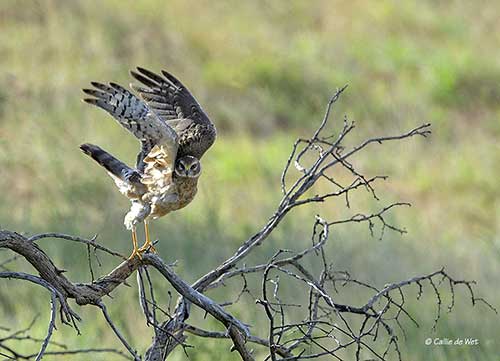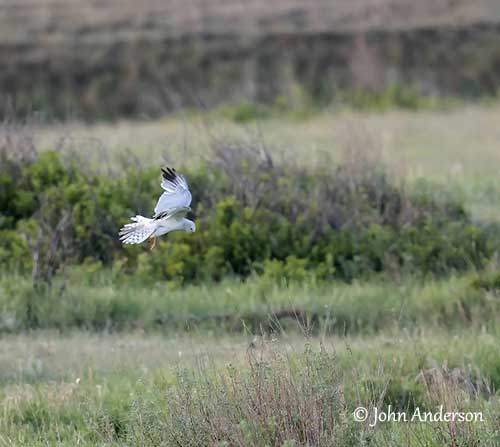
PROTECTION / THREATS / STATUS:
The Pallid Harrier is threatened on the breeding grounds by destruction and degradation of steppe grasslands converted to arable land. But burning of vegetation, grazing of wet pastures and clearance of vegetation are major threats.
On the wintering grounds, the loss of grasslands by burning, cutting and overgrazing, and the use of pesticides have negative impact on the species.
The global population is roughly estimated to number 18,000/30,000 mature individuals, with 600/2,300 mature individuals in Europe (2015).
The Pallid Harrier is currently listed as Near Threatened.
Fr: Busard pâle
Ang: Pallid Harrier
All: Steppenweihe
Esp: Aguilucho Papialbo
Ita: Albanella pallida
Nd: Steppekiekendief
Sd: stäpphök
Photographers:
John Anderson
John Anderson Photo Galleries
Niraj V. Mistry
Photo Galleries
William Price
PBase-tereksandpiper & Flickr William Price
Callie de Wet
South African Wildlife at its best...
Text by Nicole Bouglouan
Sources:
HANDBOOK OF THE BIRDS OF THE WORLD Vol 2 by Josep del Hoyo-Andrew Elliot-Jordi Sargatal - Lynx Edicions - ISBN: 8487334156
GUIDE DES RAPACES DIURNES – Europe, Afrique du Nord et Moyen-Orient de Benny Génsbol – Delachaux et Niestlé – ISBN : 2603013270
BIRDS OF PREY OF AFRICA AND ITS ISLANDS by Alan and Meg Kemp - Struik Publishers - ISBN: 1770073698
BIRDS OF AFRICA SOUTH OF THE SAHARA by Ian Sinclair and Peter Ryan - Princeton University Press Princeton and Oxford - ISBN: 0691118159
BIRDS OF THE MIDDLE EAST by R.F. Porter, S. Christensen, P Schiermacker-Ansen C.Helm - ISBN: 0713670169
Global Raptor Information Network - Working to Conserve Birds of Prey in nature
Biodiversity Explorer – The Web of Life in Southern Africa
Field identification of female and juvenile Montagu's and Pallid Harriers
Wikipedia, the free encyclopaedia
Pallid Harrier
Circus macrourus
Accipitriformes Order – Accipitridae Family
INTRODUCTION:
The Pallid Harrier is a medium-sized raptor in the genus Circus (Harrier-hawks - Harriers - Crane Hawk). Harriers have narrow wings and long tail, well-adapted to their hunting behaviour, with a good manoeuvrability in flight.
The head pattern with a conspicuous facial disk often recalls the Strigidae. The sexual dimorphism is well marked.
The Pallid Harrier breeds from Ukraine and SW Russia to NW China. It winters in India and SE Asia, but also to Africa S of Sahara.
This species breeds in open plains and dry steppes, but prefers wet grasslands near water. Similar habitats are used in winter, especially in open country. This species is solitary nester, although loose colonies are sometimes observed.
It feeds on small mammals, birds, lizards and large insects. It flies low over open vegetation and captures the prey after a sharp twist to the ground.
The Pallid Harrier is threatened by degradation and destruction of the habitat within the breeding range. In the wintering areas, modifications of the habitat and use of pesticides have a negative impact on this species.
The population is still declining and the Pallid Harrier is currently listed as Near Threatened.

DESCRIPTION OF THE BIRD:
Biometrics:
Length: 40-48 cm
Wingspan: 100-120 cm
Weight: M: 235-416 g – F: 402-550 g
The Pallid Harrier adult male has pale grey upperparts with barred white rump. On the upperwing, the four outer primaries have black tips well visible in flight. The uppertail is pale grey with darker bars.
The underparts are white, including underwing and undertail, except the black tips of the outer primaries.
The head is pale grey too.
The hooked bill is black with yellow cere. The eyes are yellow. Legs and feet are orange-yellow with black talons.
The adult female has brown upperparts with grey tinge. On the upperwing, and especially on the lesser wing-coverts, the feathers have buff tips involving scaled pattern. The rump is white. Both flight-feathers and rectrices are dark brown with buff tips. The flight-feathers show grey-brown wide bars on primaries.
Head, neck and underparts are paler, mostly rufous-brown. The breast is conspicuously streaked with chestnut, becoming pale buff on vent. Flight-feathers and tail are white with dark bars (four bars on the tail).
On the head, the crown is streaked dark brown. The dark facial mask is partially surrounded by white, and there is a paler collar around the dark ear-coverts. The bare parts are like in male.
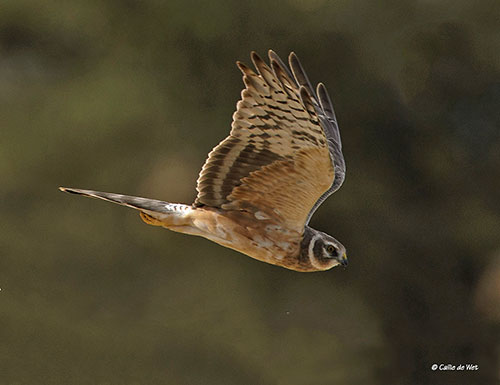
The juvenile resembles adult female but upperparts and flight-feathers are slightly darker, with more obvious buff tips to feathers forming a pale buff patch on the lesser wing-coverts. The secondaries are usually darker.
The neck sides are more rufous, less marked below. The head is paler, making the dark facial pattern and the pale collar more conspicuous. The eyes are dark brown.
The moult direct into adult plumage in the second year.
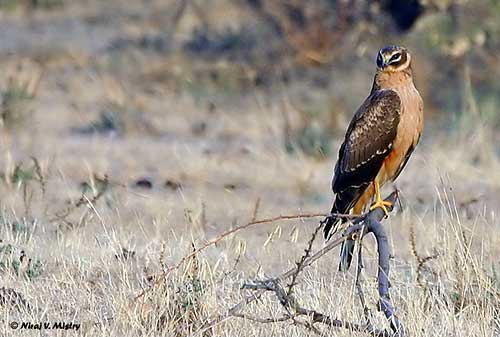
RANGE:
The Pallid Harrier breeds from Ukraine and SW Russia to NW China (Lake Balkash region) and perhaps N Mongolia S to Turkey and Iran. It breeds irregularly farther W to Sweden, Germany and Netherlands.
It winters mainly in Africa S of Sahara, and also from Pakistan, India and Sri Lanka, E to S and sometimes E China.
Some birds may remain in SE Europe, North Africa and the Middle East.
HABITAT:
The Pallid Harrier breeds in grassy plains and dry steppes, both in flat terrain or on slopes, also in valleys with dry vegetation and semi-desert, sometimes in farmland, but it prefers wet grasslands near water or marshland. It occurs up to 2,000 metres of elevation.
During winter, it frequents similar habitats and also wheat fields and sandy islands in Indus delta in Pakistan. In W Africa, it can be seen in open woodlands and mountain plateaux. It may occur up to 3,000 metres in Himalayas and Africa.
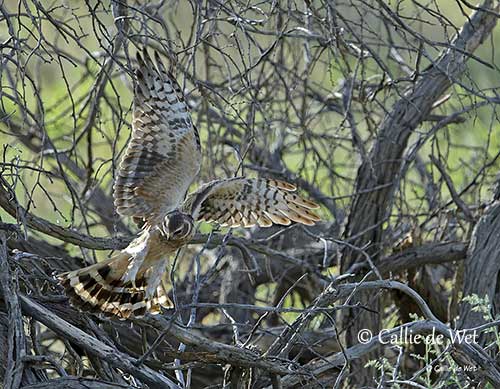
CALLS AND SONGS: SOUNDS BY XENO-CANTO
The Pallid Harrier is mostly silent outside of breeding season, except some chatting at communal roosts.
It produces a fast, high chatter described as “kik-ik-ik-ik-ik-ik…” like the calls of the Montagu’s Harrier and the Hen Harrier.
The food call by the female is “piir piir…” and the alarm call at nest is a repeated “gigigig kirrrk”.
BEHAVIOUR IN THE WILD:
The Pallid Harrier feeds mainly on large insects taken from the ground or in the air such as locusts, grasshoppers and beetles. But it also takes birds (larks and pipits), small mammals (voles, mice and gerbils) and reptiles (lizards).
It hunts almost all day round and may forage up to 20 kilometres from the roost. It flies low over the vegetation and often lands on the ground instead on a perch.
Once a prey is spotted on the ground, it drops down while performing a sharp twist to catch the prey. It often hides in tall grass, prior to catch larks feeding in flocks on the ground.
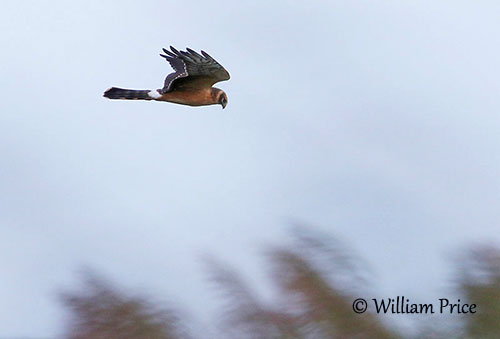
The Pallid Harrier roosts on the ground, singly or communally, often in patch of tall grass.
The courtship displays of this species are similar to the courtship behaviour of the Hen Harrier. The male performs spectacular aerial displays while the female is perched, before to fly away and join the male. At they are flying very high, they dive together. Before to rise again, the female turns onto her back and presents her talons to the male, but they do not grasp them.
They are monogamous. The nest is built on the ground, not far from water, and hidden among tall grasses or bushes. Both mates share the nesting duties, but the female incubates alone, while the male feeds her.
The Pallid Harrier is migratory and moves in August-September, leaving its breeding grounds to perform a long-distance migration to warmer and tropical ranges.
Asian populations migrate to E Africa and S Asia, whereas European populations move only to Africa. They leave the wintering areas in March-April and return to their distant breeding grounds. They migrate singly or in small groups.
The Pallid Harrier spends more time in flight than other harriers. The wings appear narrower and more pointed, and the tail is longer than in other species.
The flight is agile and buoyant, with the wings held in high V-shape, almost like a small gull.
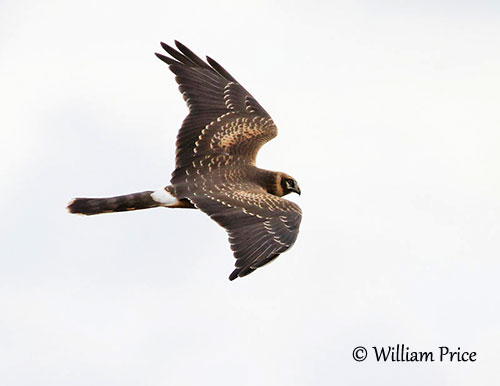
REPRODUCTION OF THIS SPECIES:
The laying occurs in May-June.
The Pallid Harrier nests solitary or in loose groups of 3-5 pairs, sometimes up to 30 with the Montagu’s Harrier.
The breeding sites usually change, but they depend on rodent’s populations.
The nest is on the ground, often in swamp or among grass, usually fairly close to water. This structure is a pile of grass placed among the vegetation, protected by low scrub, weeds or tall grass.
The female lays 3-6 (4-5) white eggs, and incubates alone during about one month. She is fed by the male during this period. Usually, two or three young fledge in 35-40 days. The food is provided by the male, but when the chicks are older, both parents forage together and feed the young.
The young harriers remain with their parents for 2-3 weeks after fledging. They are sexually mature at 2-3 years, although some birds breed before the full adult plumage.
